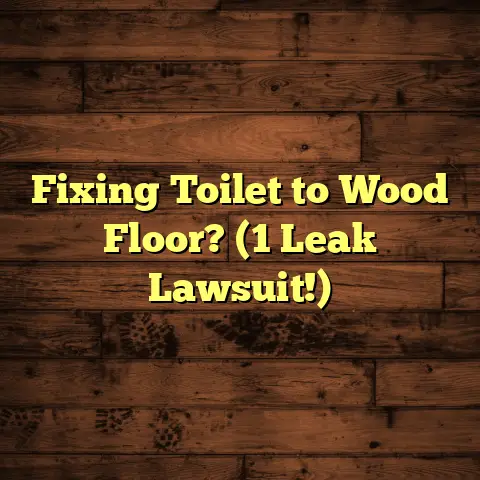Soak Up Basement Water? (1 Call To Avoid!)
As a flooring contractor for over 20 years, I’ve seen it all, from minor dampness to full-blown floods.
And believe me, dealing with basement water the right way can save you a ton of headaches, money, and even protect your health.
But there’s one call you absolutely want to avoid making when you first spot that unwelcome moisture.
Stick with me, and I’ll tell you which one it is and, more importantly, what to do instead.
Introduction: Eco-Friendly Options for Water Management
Why am I so passionate about this? Because I’ve seen firsthand the damage that water can do, and I know there are better, more sustainable ways to tackle the problem.
We’re not just talking about getting rid of water; we’re talking about managing it responsibly. Think about it: every drop of water we divert from our basements can be used to nourish our gardens, reduce our water bills, and ease the strain on municipal systems.
Eco-friendly solutions are the future. They’re better for your home, your wallet, and the planet. Let’s dive into how you can make your basement dry and green.
Did you know? According to the EPA, the average household can save thousands of gallons of water each year by implementing simple water conservation strategies. Eco-friendly basement solutions fit right into that picture!
Section 1: Understanding Basement Water Issues
Alright, first things first: let’s get on the same page about what we’re dealing with.
Common Basement Water Problems
We’re talking about a few usual suspects here:
- Leaks: These can be sneaky, often starting as small drips from cracks in the foundation.
- Flooding: The worst-case scenario, often caused by heavy rain, sewer backups, or groundwater issues.
- Humidity: Even without visible water, high humidity can lead to mold growth and musty smells.
Sources of Water Intrusion
Where’s all this water coming from?
- Groundwater: The water table can rise and seep through your foundation.
- Surface Runoff: Rainwater that isn’t properly diverted away from your house.
- Plumbing Failures: Burst pipes or leaky water heaters can cause major problems.
Fun fact: A single burst pipe can release hundreds of gallons of water in just a few hours. Imagine the damage to your basement!
Implications of Water Issues
Why should you care about a little water? Because it can lead to:
- Health Problems: Mold and mildew can trigger allergies and respiratory issues.
- Structural Damage: Water can weaken your foundation and cause wood to rot.
- Reduced Property Value: A damp or moldy basement is a major turn-off for potential buyers.
Section 2: Traditional Methods of Managing Basement Water
Okay, so what have people been doing about this for years?
Conventional Methods
The usual suspects include:
- Sump Pumps: These pump water out of a pit in your basement.
- French Drains: These divert water away from your foundation using perforated pipes.
Pros and Cons
Let’s be real, these methods have their downsides:
- Sump Pumps: They require electricity, can fail during power outages, and don’t address the root cause of the problem.
- French Drains: They can be expensive to install and can clog over time.
Environmental Impact
Traditional methods aren’t always the greenest:
- Energy Consumption: Sump pumps use electricity, contributing to carbon emissions.
- Water Waste: Sump pumps often discharge water into storm drains, wasting a valuable resource.
Sustainable Alternatives
Here’s where things get interesting:
- Rainwater Harvesting Systems: Collect rainwater for irrigation or other uses.
- Permeable Paving: Allows water to soak into the ground instead of running off.
These solutions not only manage water but also reduce your environmental footprint.
Section 3: Eco-Friendly Solutions for Basement Water Issues
Now, let’s get into the nitty-gritty of eco-friendly solutions.
Natural Drainage Solutions
These are ways to work with nature, not against it:
- Bioswales: Planted channels that filter and slow down water runoff.
- Green Roofs: Roofs covered in vegetation that absorb rainwater.
Imagine turning your roof into a garden that helps keep your basement dry!
Eco-Friendly Waterproofing Products
Traditional waterproofing can be full of harsh chemicals. Luckily, there are greener options:
- Water-Based Sealants: These have lower VOCs (volatile organic compounds) than solvent-based sealants.
- Clay-Based Waterproofing: Natural clay can create a waterproof barrier.
Landscaping for Water Management
Your yard can be your best defense against basement water:
- Grading: Make sure your yard slopes away from your house.
- Planting: Use native plants that absorb water.
Pro tip: Avoid plants that need a lot of water near your foundation.
Section 4: Innovative Technologies and Materials
The world of basement waterproofing is constantly evolving.
New Eco-Friendly Technologies
Check out these advancements:
- Energy-Efficient Dehumidifiers: These use less energy to remove moisture from the air.
- Moisture-Absorbing Materials: Special materials that can soak up water and release it slowly.
Sustainable Building Materials
When renovating your basement, consider:
- Recycled Concrete: Made from recycled materials.
- Bamboo Flooring: A sustainable and water-resistant flooring option.
Case Studies
I’ve seen these methods work wonders. For example, a client of mine in Chicago had chronic basement flooding. We installed a rainwater harvesting system and bioswales, and the problem was solved!
Plus, they were thrilled to have a beautiful garden that helped the environment.
Section 5: The One Call to Avoid
Okay, here’s the moment you’ve been waiting for. The one call you should absolutely avoid making when you discover basement water?
Calling the cheapest, fastest “solution” without doing your research.
Why Avoid This Call?
Because it can lead to:
- Band-Aid Fixes: Addressing the symptom (the water) without fixing the cause.
- Unqualified Contractors: People who don’t understand the underlying issues and may make things worse.
- Unsustainable Solutions: Methods that harm the environment or don’t last.
Potential Repercussions
Ignoring eco-friendly options can have serious consequences:
- Financial: You might end up paying more in the long run for repeated repairs.
- Environmental: You could be contributing to water waste and pollution.
- Practical: You might still have a wet basement, despite spending money on “solutions.”
Homeowner Regrets
I’ve heard horror stories from homeowners who went with the cheapest option. One client told me they hired a contractor who installed a cheap sump pump that failed after just a few months. They ended up spending even more money to fix the problem properly.
Section 6: Practical Steps for Homeowners
So, what should you do instead of making that one call?
Assess Your Basement
Here’s a step-by-step guide:
- Identify the Source: Where is the water coming from?
- Check the Gutters: Are they clean and draining properly?
- Look for Cracks: Inspect your foundation for cracks.
- Monitor Humidity: Use a hygrometer to measure humidity levels.
Eco-Friendly DIY Solutions
Here are some simple things you can do yourself:
- Improve Grading: Make sure your yard slopes away from your house.
- Clean Gutters: Remove leaves and debris regularly.
- Seal Cracks: Use a water-based sealant to fill small cracks.
Maintenance Tips
Prevent future water issues with these tips:
- Regular Inspections: Check your basement regularly for signs of water.
- Maintain Gutters: Clean them at least twice a year.
- Monitor Humidity: Use a dehumidifier if necessary.
Remember: Prevention is key!
Conclusion
Look, dealing with basement water can be a pain. But it doesn’t have to be a drain on your wallet or the environment. By choosing eco-friendly solutions and avoiding that one disastrous call, you can create a dry, healthy basement that adds value to your home.
Don’t just soak up the water. Manage it responsibly! Take proactive steps, and you’ll be well on your way to a dry and sustainable basement.
And if you need help, don’t hesitate to reach out to a qualified contractor who understands eco-friendly solutions. Trust me; it’s worth it in the long run.





